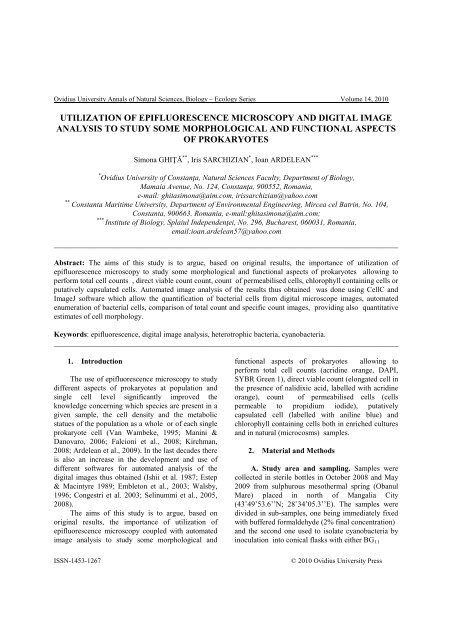VOLUM OMAGIAL - Facultatea de Ştiinţe ale Naturii şi Ştiinţe Agricole
VOLUM OMAGIAL - Facultatea de Ştiinţe ale Naturii şi Ştiinţe Agricole
VOLUM OMAGIAL - Facultatea de Ştiinţe ale Naturii şi Ştiinţe Agricole
Create successful ePaper yourself
Turn your PDF publications into a flip-book with our unique Google optimized e-Paper software.
Ovidius University Annals of Natural Sciences, Biology – Ecology Series Volume 14, 2010<br />
UTILIZATION OF EPIFLUORESCENCE MICROSCOPY AND DIGITAL IMAGE<br />
ANALYSIS TO STUDY SOME MORPHOLOGICAL AND FUNCTIONAL ASPECTS<br />
OF PROKARYOTES<br />
Simona GHIŢĂ ** , Iris SARCHIZIAN * , Ioan ARDELEAN ***<br />
* Ovidius University of Constanţa, Natural Sciences Faculty, Department of Biology,<br />
Mamaia Avenue, No. 124, Constanţa, 900552, Romania,<br />
e-mail: ghitasimona@aim.com, irissarchizian@yahoo.com<br />
** Constanta Maritime University, Department of Environmental Engineering, Mircea cel Batrin, No. 104,<br />
Constanta, 900663, Romania, e-mail:ghitasimona@aim.com;<br />
*** Institute of Biology, Splaiul In<strong>de</strong>pen<strong>de</strong>nţei, No. 296, Bucharest, 060031, Romania,<br />
email:ioan.ar<strong>de</strong>lean57@yahoo.com<br />
__________________________________________________________________________________________<br />
Abstract: The aims of this study is to argue, based on original results, the importance of utilization of<br />
epifluorescence microscopy to study some morphological and functional aspects of prokaryotes allowing to<br />
perform total cell counts , direct viable count count, count of permeabilised cells, chlorophyll containing cells or<br />
putatively capsulated cells. Automated image analysis of the results thus obtained was done using CellC and<br />
ImageJ software which allow the quantification of bacterial cells from digital microscope images, automated<br />
enumeration of bacterial cells, comparison of total count and specific count images, providing also quantitative<br />
estimates of cell morphology.<br />
Keywords: epifluorescence, digital image analysis, heterotrophic bacteria, cyanobacteria.<br />
__________________________________________________________________________________________<br />
1. Introduction<br />
The use of epifluorescence microscopy to study<br />
different aspects of prokaryotes at population and<br />
single cell level significantly improved the<br />
knowledge concerning which species are present in a<br />
given sample, the cell <strong>de</strong>nsity and the metabolic<br />
statues of the population as a whole or of each single<br />
prokaryote cell (Van Wambeke, 1995; Manini &<br />
Danovaro, 2006; Falcioni et al., 2008; Kirchman,<br />
2008; Ar<strong>de</strong>lean et al., 2009). In the last <strong>de</strong>ca<strong>de</strong>s there<br />
is also an increase in the <strong>de</strong>velopment and use of<br />
different softwares for automated analysis of the<br />
digital images thus obtained (Ishii et al. 1987; Estep<br />
& Macintyre 1989; Embleton et al., 2003; Walsby,<br />
1996; Congestri et al. 2003; Selinummi et al., 2005,<br />
2008).<br />
The aims of this study is to argue, based on<br />
original results, the importance of utilization of<br />
epifluorescence microscopy coupled with automated<br />
image analysis to study some morphological and<br />
functional aspects of prokaryotes allowing to<br />
perform total cell counts (acridine orange, DAPI,<br />
SYBR Green 1), direct viable count (elongated cell in<br />
the presence of nalidixic acid, labelled with acridine<br />
orange), count of permeabilised cells (cells<br />
permeable to propidium iodi<strong>de</strong>), putatively<br />
capsulated cell (labelled with aniline blue) and<br />
chlorophyll containing cells both in enriched cultures<br />
and in natural (microcosms) samples.<br />
2. Material and Methods<br />
A. Study area and sampling. Samples were<br />
collected in sterile bottles in October 2008 and May<br />
2009 from sulphurous mesothermal spring (Obanul<br />
Mare) placed in north of Mangalia City<br />
(43˚49’53.6’’N; 28˚34’05.3’’E). The samples were<br />
divi<strong>de</strong>d in sub-samples, one being immediately fixed<br />
with buffered formal<strong>de</strong>hy<strong>de</strong> (2% final concentration)<br />
and the second one used to isolate cyanobacteria by<br />
inoculation into conical flasks with either BG11<br />
ISSN-1453-1267 © 2010 Ovidius University Press





